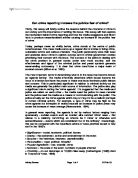The Pornography of fear
- The media’s utilization of crime has increased fear of crime in society, but it may not be a precise interpretation.
- The author first presents support for his thesis in the first sentence of paragraph two, he says, “Britain has one of the lowest crime rates in Europe, yet it has the highest fear of crime.” This quote automatically informs the reader that the public’s fear of crime is not justified. The author supports this further in the first line of paragraph three: “Fear of crime is not crime. It is fear.” The author then starts to verify that the media takes advantage of fear by saying, in the third last sentence of paragraph three, “The politician plays on public…in his protection”. He then begins to expand his point by conducting a survey, which is called the MORI poll. In paragraph four, second and third sentences he states “This is not some police…This is a measure of something real”. The author clarifies a rational link connecting fear and crime in paragraph six, in the last sentence, where he finishes the thought by stating, “If crime falls, fear should fall.” On the contrary the author says in the second last sentence of paragraph seven, “A feature of fear…by imagination.” In this quote the author is explaining that the fear in media is derived from true facts, with exaggeration.







